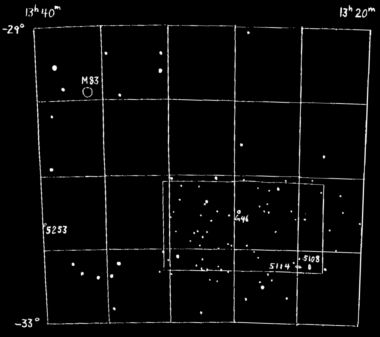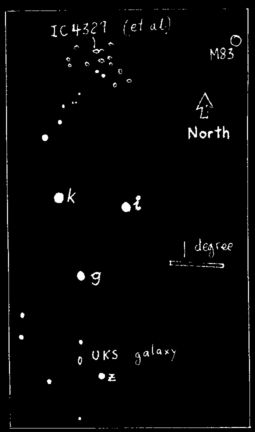BNGC 17. Return Of the Centaur
Back to Index of Beyond the NGC
By Steve Mencinsky, 1994
Autumn - season of mists and Star Parties... but much more importantly, the first opportunity for serious observation of Centaurus. Only two weeks after last May's apocalyptic BNGC article about this constellation, in which your correspondent wistfully mentioned the lack of a suitable chart for the Western portion of the Centaurus chain, Joe Cauchi arrived at a meeting with... you guessed it, a print of a photo he had taken of the Western portion of the Centaurus chain! Your correspondent hurriedly drew in the extra details and was able to successfully observer and record what you see on this month's chart #1.
As in some previous BNGC charts, stars given in Uranometria (U II) are drawn with crosses; while non-stellar items of interest are given Herschellian NGC style descriptions. The NGC and A, B, C, D galaxies were observed quite routinely. The area around NGC 4645A and B is visually the most interesting portion: two large bright spindle galaxies scattered around an 8th magnitude star.
Photographically, the focus of interest is in the "Centaurus chain" itself: NGC 4661 through NGC 4603A, centred on 4650A which the ESO book describes as "utterly peculiar" and compare it with Centaurus A - a comparison that quite frankly escapes your correspondent.
 On comparing the NW portion (i.e., this month's) with the previous South-Eastern side of this great cluster of galaxies, an intriguing disparity is noted in what U II shows as compared with what was visually observed. In both cases, all U II galaxies were successfully observed. However, U II indicates the NW portion as being much denser. In fact, that is the direct opposite of what was observed. In the NW, the U II coverage is almost complete - only a small handful of galaxies was seen (both in the sky and on Joe's photo) above and beyond what U II charted. Conversely, in the SE, the number of galaxies successfully observed was more than twice what is shown in U II and the density of galaxies here (in terms of successfully observed galaxy per square unit of sky) is considerably higher.
On comparing the NW portion (i.e., this month's) with the previous South-Eastern side of this great cluster of galaxies, an intriguing disparity is noted in what U II shows as compared with what was visually observed. In both cases, all U II galaxies were successfully observed. However, U II indicates the NW portion as being much denser. In fact, that is the direct opposite of what was observed. In the NW, the U II coverage is almost complete - only a small handful of galaxies was seen (both in the sky and on Joe's photo) above and beyond what U II charted. Conversely, in the SE, the number of galaxies successfully observed was more than twice what is shown in U II and the density of galaxies here (in terms of successfully observed galaxy per square unit of sky) is considerably higher.
Still in the ESO book (into which BNGC has already dipped so heavily), its plate 99 offers a negative print of an apparently barren area of sky two degrees due west of the midpoint between M83 and NGC 5253 (both very bright galaxies). "Barren" is indeed an understatement: except for the very very corner of the plate there is not a single NGC object; nor is there any star as bright as 8th magnitude. In fact, the very drought of navigation beacons in this area seems ample justification for providing both small and large scale charts of this area. However, with some fairly simple (if somewhat lengthy) navigation, a veritable feast of galaxies is there for the observing.
 Chart #2 shows the location of the ESO plate with respect to U II chart 370. Only in the portion occupied by the ESO plate are all U II stars shown; outside of this area only stars to magnitude 6 are plotted.
Chart #2 shows the location of the ESO plate with respect to U II chart 370. Only in the portion occupied by the ESO plate are all U II stars shown; outside of this area only stars to magnitude 6 are plotted.
Chart #3 covers the same area as the ESO plate. It also shows some additional, fainter stars that were used to home in on the galaxies shown. Only those successfully observed are drawn. The plate shows many more galaxies with seemingly similar size/brightness/density characteristics; doubtless a more patient observer than your correspondent could populate this chart with even more successes.
 Finally, as if to demonstrate the seemingly endless riches that Centaurus has to offer, Charts #4 and #5 shows yet another bright uncharted galaxy in Centaurus, again near to M83. To the best of your correspondents knowledge, this
Finally, as if to demonstrate the seemingly endless riches that Centaurus has to offer, Charts #4 and #5 shows yet another bright uncharted galaxy in Centaurus, again near to M83. To the best of your correspondents knowledge, this
galaxy, "officially" found by the UK Schmidt telescope, seems to have been first brought to the attention of the Australian amateur by Queensland's Zac Pujic.
Indeed, Zac and your correspondent succesfully observed this galaxy through our respective telescopes during the 1993 Queensland AstroFest (A highly succesful social and observational event); further succesful observations from Ilford and elsewhere followed. The size and surface brightness of this galaxy suggest that success could well be had even with a 10" telescope - yet again a Centaurus galaxy that probably "should" have been an NGC.
Had it been so, however, it would not then have been a BNGC!



